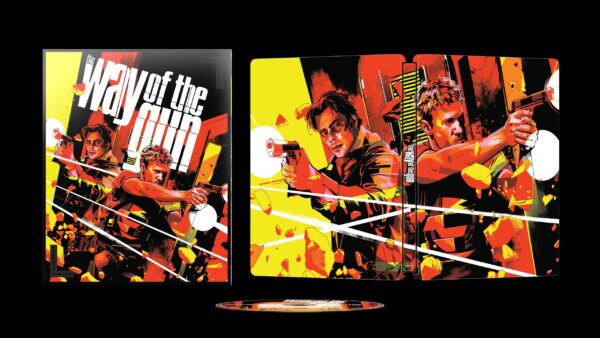
In 2000, Christopher McQuarrie was riding high on the success of his Oscar nominated screenplay The Usual Suspects, but he was unable to convince anyone to let him direct. At the urging of star Benicio del Toro, he wrote another crime screenplay and made it on the cheap on the condition that he a) could direct and b) had final cut.
That movie is The Way of the Gun.
The film feels like a very specific time capsule. McQuarrie’s dialogue and characters are indebted to both The Usual Suspects, as well as Quentin Tarantino (knock-offs of the latter’s films were still coming out with some regularity at this time).
The plot is both incredibly simplistic and highly convoluted. Parker (Ryan Phillippe) and Longbaugh (del Toro) are criminals living on the margins of society – getting by financially by donating their sperm while planning the proverbial “big score.”
Opportunity knocks in the form of pregnant surrogate Robin (Juliette Lewis), who is carrying the child of money launderer Hale Chidduck (Scott Wilson) and his chilly trophy wife Francesca (Kristin Lehman). The kidnapping instigates a series of violent responses from not only Chidduck’s bodyguards Jeffers (Taye Diggs) and Obecks (Nicky Katt), but also a bagman named Joe Sarno (James Caan) and his friend Abner Mercer (Geoffrey Lewis).
In true crime movie fashion, no one fully trusts each other. Things begin to go sideways when Parker and Longbaugh question each other’s motives, while Jeffers and Obecks hatch a plan to redeem themselves that actively risks the lives of both Robin and her doctor, Allen Painter (Dylan Kussman), who has much more invested in the plot than initially meets the eye.
Naturally all of these competing interests ensure that nothing goes according to plan as the action shifts from the city to the desert for one final confrontation that tests alliances and leaves several characters severely injured or dead.

The Way of the Gun very clearly toes the line between neo-crime film and Western (McQuarrie apparently drew on his love of films like The Magnificent Seven and Bad Day at Black Rock). The dialogue and double-crossing leaning towards the former genre with the dusty settings and the focus on gunplay belonging to the latter.
The shifting genres complement the morally murky convictions of most of the characters. McQuarrie famously set out to make a film anchored by unlikable lead characters, so it’s a testament to del Toro and Philippe that Longbaugh and Parker are so compellingly watchable. They’re initially presented as petty criminals with a capacity for violence and a lack of empathy and only as the film progresses does it become clear that both men have more depth.
Del Toro negotiates this tone more deftly than Philippe, who is less convincing as a criminal and struggles more with McQuarrie’s hard-boiled dialogue (the voice-over that opens and closes the film are particularly cumbersome). On the other hand, playing a nearly monosyllabic character works in del Toro’s favour: Longbaugh comes across as more mysterious and many of del Toro’s subtle/silent acting choices earn big laughs.

It is in the film’s back half, when the setting becomes more Western and characters dig in in anticipation of the climax, that The Way of the Gun loses its momentum. While certain moments, including a dusty motel face-off and the final shoot-out at the brothel are thrilling, the pacing of the nearly two hour runtime feels draggy and slow for long stretches.
This isn’t helped by the seemingly arbitrary motivations of Jeffers and Obecks, whose decision-making is dictated more by plot than character. While both are talented actors, neither can hold their own against Caan, who steals every scene he’s in, especially his commanding introductory scene set in a tiny police interrogation room.

Complaints aside, the bloody and extended resolution of the film satisfies both action fans and offers an unique sense of catharsis and resolution for our anti-heroes. It is an appropriate end: for them and the film.
Ultimately The Way of the Gun is a solid directorial calling card for McQuarrie, particularly as a demonstration of his ability to handle multiple types of action. As strong as the squib-heavy finale is, one of the film’s most memorable sequences is what is often described as “the world’s slowest car chase” down multiple alleys, in which characters literally walk their cars in pursuit of each other. It’s a testament to McQuarrie’s keen visual eye that he’s able to make such an unorthodox sequence so enthralling, something that has been on display in no shortage of Tom Cruise action films over the last few decades.
And The Way of the Gun is where it all started.
4K Steelbook Extras
In addition to McQuarrie’s legacy audiocommentary and stunningly gorgeous cover art by Matt Taylor, the disc contains two new featurettes:
- “Intention is Everything” (20 minutes): A comprehensive interview with Production Designer Maia Javan and Art Director Thomas Meyer, who discuss their collaborative process with each other and McQuarrie. Lots of interesting tidbits here, including how they dressed the brothel and what a coup it was finding the mansion used for the Chiddick house in Salt Lake City, Utah (where the film was shot).
- “Trigger Discipline” (8 minutes): A shorter featurette on the incredible wealth of weapons used in the film and how they prepped the actors to convincingly handle them. The writer/director’s brother Doug McQuarrie was the weapons consultant and personally took charge of the “choreography” for the gunplay to ensure it looked convincing. Prop master Ian Roylance walks us through all of the guns, how they were sourced for the film, and reveals that “1000s” of squibs (explosives used to simulate the impact of bullets) were used in the final battle.
The Way of the Gun 4K Steelbook is available for purchase now
- Film: 3/5
- Disc: 3/5